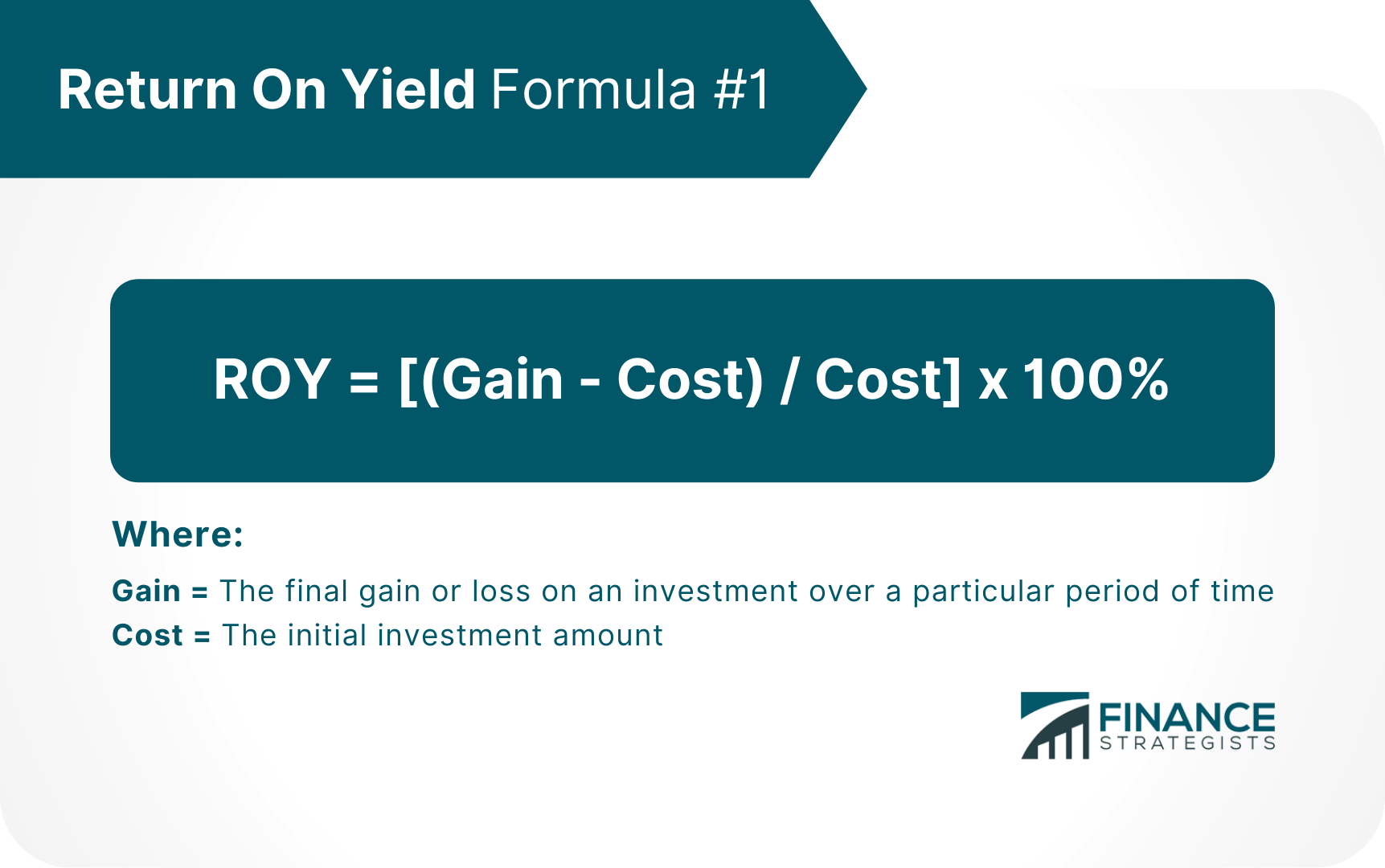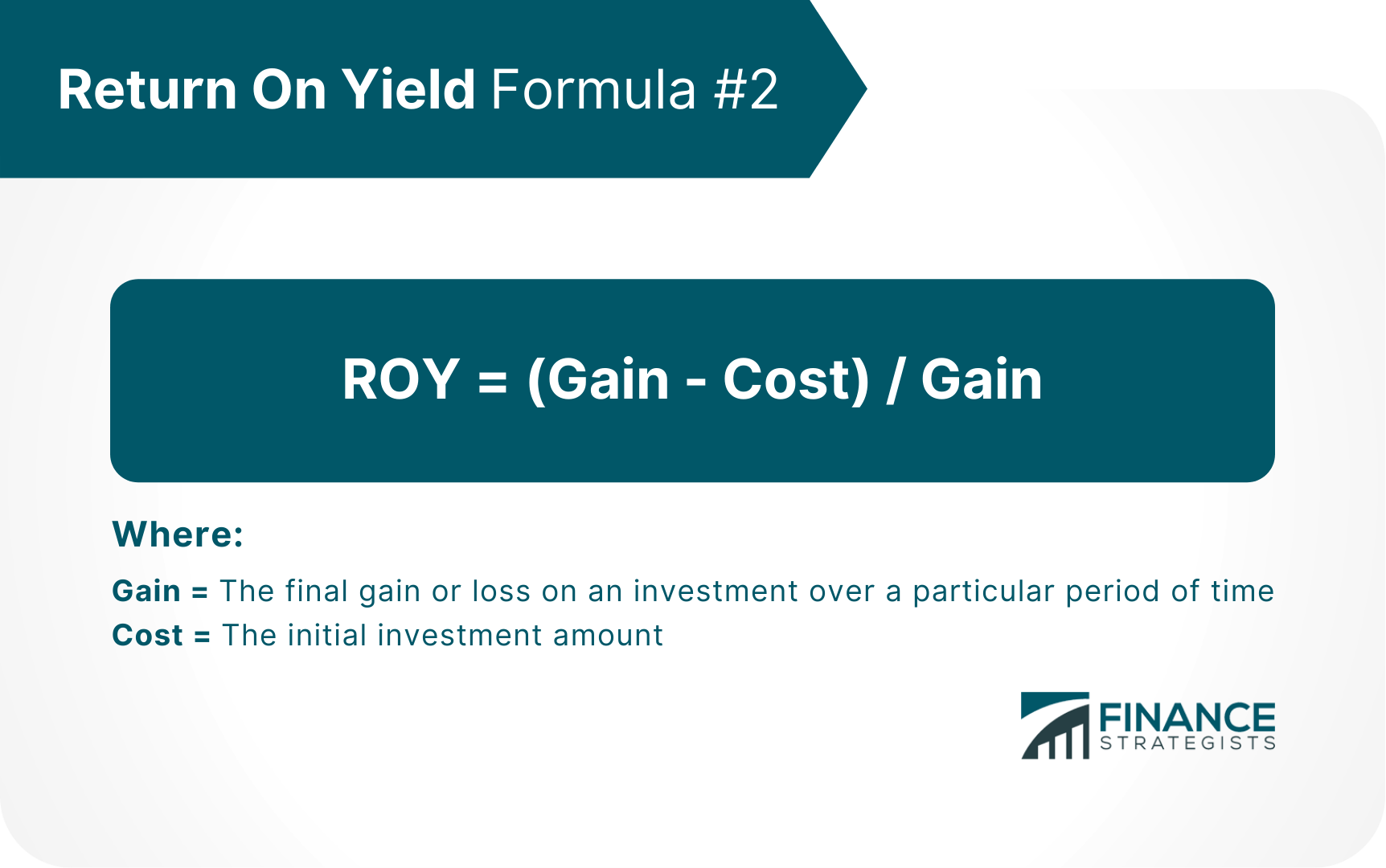Return on yield, or ROY, is a key metric for measuring the profitability of an investment. It tells you how much money you earned on your investment, expressed as a percentage of the original investment. Considering that different investments may yield different results and vice versa, ROY may also account for the time period over which it is measured. The higher the ROY percentage, the more advantageous it is to have invested in that particular security or investment. ROI, or return on investment, is a more commonly used term. However, it is important to understand the distinction between the two. ROI measures your profits against the amount of money you originally invested. This makes it a good tool for comparing different types of investments. ROY, on the other hand, looks at how much money you made on a particular investment, regardless of how much you initially invested. In other words, ROY tells you how much you earned on your investment, while ROI tells you how successful your investment was. The return you receive on your investment is pivotal in the growth of your investment over time. There are two main reasons to pay attention to your ROY when considering stocks: 1) It's an indication of how much money has been made after investing in a particular company. If, for example, you earn a 20% ROY in one year and reinvest the money (called compounding) in the same company for another year, you will have made 40% on your investment. Compounding is important because it increases your annual return regardless of how much or how little your investments gain over time. 2) A high ROY is indicative of a profitable company. ROY tells the investor how much money has been generated by an investment after taking factors like cost of production (materials, etc.), selling expenses (marketing, etc.), and taxes into consideration. For example, if Coca-Cola's ROY is 10%, it means that for every $100 you've invested in the company, you've made $10 in profits. Therefore, it should be used as one of the many financial ratios that determine whether or not a company is successful. Since ROY is a percentage, it can be used to compare companies within the same industry and across industries. This allows you to determine which companies are most worthwhile based on how much money they make. As such, ROY should be considered when making investment decisions for your portfolio. Another important factor for ROY is the time frame in which it is measured. Many analysts debate between annual return on yield, or AROY, and compound return on yield, or CARY. A ROY tells you how much money you've averaged over a one-year period. For example, if your $10 investment yielded $1 every year, your AROY would be 10%. The CARY, on the other hand, tells you how much money your investment made in a one-year period without averaging it. In this example, you would have made $1 in the first year and $2 every subsequent year thereafter. Both numbers are just as important to understand when making investment decisions. There are several methods for determining ROY, but the most common formula is: You can also use the formula: However, due to compounding, your ROY will depend heavily on which formula you use. For example, if you had invested $10 in a company, your ROY would have been 10% if you use the first formula. However, using the second formula may yield either 8% or 12%, depending on whether or not you reinvested future earnings back into the investment. With the formulas above, it's easier to calculate ROY in some situations than others. For example, assume you invest $10,000 in a company with an 8% ROY. Formula 1: If you reinvest your earnings from the first year back into the investment, your ROY would be 10%. ROY = [(Gain - Cost) / Cost] x 100% Formula 2: ROY = (Gain - Cost) / Gain Another example, you invest $10,000 in a new company with the goal of earning a 20% return. Formula 1: If you reinvest your earnings from the first year back into the investment, you would earn a 25% return. Formula 2: ROY = (Gain - Cost) / Gain One of the most important factors in determining a company's return on yield is its business and industry type. For example, if you were to invest in a financially-based company, your ROY would likely be much higher than if you had invested in a technology-based company. This is due to the inherent risk associated with investing in certain industries. Another important factor is the company's debt-to-equity ratio. A high debt-to-equity ratio means that the company is taking on a lot of debt, which can lead to an increase in expenses and a decrease in earnings. In this case, the company's ROY would be lower than if they hadn't taken on as much debt. In order to ensure that you're making good investment decisions, it's wise to research a company's debt-to-equity ratio before you invest. Otherwise, you may be overestimating your potential earnings. While a high debt-to-equity ratio is bad for a company, a low debt-to-equity ratio is usually good. This is because a low debt-to-equity ratio indicates that the company is using less debt to finance its operations, which means it has more money to invest in itself. However, don't assume that a low debt-to-equity ratio always indicates a high return on yield. It's still important to understand the company's industry and how much debt they are taking on. Reinvestment of earnings is another important factor to consider when calculating ROY. When you reinvest your earnings, you're allowing your money to grow at a higher rate than if you left it in a savings account or used it to purchase more shares of the company. This is because reinvested earnings allow you to buy more shares of the company at a lower price, which increases your earnings when you sell. It's important to understand how companies are calculating their return on yield before you invest in them. While high ROY can be good for a company, you need to ensure that the business is still sustainable and won't go under if its earnings decrease. If you have any questions about determining your own return on yield, reach out to your financial advisor for more information. Difference Between ROY and ROI
Why Should You Care About Your ROY
The Importance of a Good ROY for Investing in Stocks
How To Calculate Return On Yield


Return on Yield Sample Calculation
A year later, your investment is worth $10,800.
ROY = [(10,800 - 10,000) / 10,000] x 100%
ROY = 0.1 or 10%
ROY = ($10,800 - $10,000) / $10,800
ROY = 0.08 or 8%
ROY = [(Gain - Cost) / Cost] x 100%
ROY = [(25,000 - 10,000) / 10,000] x 100%
ROY = 0.25 or 25%
ROY = (20,000 - 10,000) / 10,000
ROY = 2 or 20%What Are Some Factors That Affect ROY?
Industry Type
Debt-To-Equity Ratio
Reinvestment of Earnings
Final Thoughts
Return on Yield (ROY) FAQs
Return on yield, or ROY, is a metric used to measure the percentage of gain or loss on an investment over a particular period of time.
ROI measures the percentage of gain or loss on an investment over the entire life of the investment. ROY, on the other hand, measures the percentage of gain or loss on an investment.
There are two formulas that can be used to calculate ROY: First formula: ROY = [(Gain - Cost) / Cost] x 100% Second formula: ROY = (Gain - Cost) / Gain
The second formula is used when the reinvestment of earnings is taken into account. For example, if you earn a 10% return on your investment in the first year, but reinvest that money back into the investment, your ROY for the second year would be 11.1%.
Some factors that can affect a company's return on yield include: - Industry type - Debt-to-equity ratio - Reinvestment of earnings
True Tamplin is a published author, public speaker, CEO of UpDigital, and founder of Finance Strategists.
True is a Certified Educator in Personal Finance (CEPF®), author of The Handy Financial Ratios Guide, a member of the Society for Advancing Business Editing and Writing, contributes to his financial education site, Finance Strategists, and has spoken to various financial communities such as the CFA Institute, as well as university students like his Alma mater, Biola University, where he received a bachelor of science in business and data analytics.
To learn more about True, visit his personal website or view his author profiles on Amazon, Nasdaq and Forbes.











